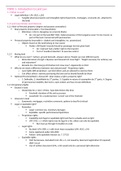TOPIC 1- Introduction to Land Law
1.1 What is Land?
Legal definition- LPA 1925, s.205
o Tangible physical property and Intangible rights (Easements, mortgages, covenants etc. attached to
the land)
1.2 Land Law Estates and Interests
1.2.1 Real vs Personal property (degree and purpose annexation)
Real property (immovable’s- free/leaseholds)
o Elitestone v Morris- Bungalow on concrete blocks
AC- not part of the land BUT HofL- Nature/purpose of the bungalow wasn’t to be moved, so
part of the land. Concerned with permanence
Personal property (moveable’s- chattels and intangibles, Inc. possessions)
o Objects found on the land belong to true owner
Parker v BA Board- bracelet found by passenger but not given back
AC- Claimant had a better right to the bracelet
Test of ‘manifest intention’ to exercise control
1.2.2 Buying land
What do you own?- Surface, ground beneath, airspace above. People can own different parts
o Baron Bernstein of Leigh v Skyviews and General Ltd- How high?- “height necessary for ordinary use
and enjoyment”
o Bocardo SA v Star Energy UK Onshore Ltd- How Low?- Apparently no limit
Why do we need a difference between real and personal?- Proprietary rights
o Land rights ARE proprietary- can bind others and are allowed to exercise them
o Can affect others- anyone purchasing the land can be bound/benefit by them
National Provincial Bank v Ainsworth- what makes a right a property right?
o 1. Definable, 2. Identifiable by 3rd parties, 3. Capable in nature of assumption by 3 rd party, 4. Degree
of permanence/stability. But test is; open ended, and has circular definitions
1.2.3 Proprietary Rights
Estates in land
o Ownership for a ‘slice’ of time. Type determines this time
Freehold- duration of life and successors
Leasehold- for a stated period, ‘carved’ out of the freehold
Interests in land
o Easements, mortgages, restrictive covenants, options to buy/first refusal
Legal or equitable right?
o Remedies-
Legal- common law, monetary damages
Equitable- specific performance/injunctions
o Proprietary rights
Capability test (legal or equitable right) and has to actually exist as right
LPA 1925, s.1- which rights may be legal in a list, others can only be equitable
But must go through formalities to exist
o Legal rights
By deed- LPA 1989, s.1 with short lease exception (LPA 1925, s.54)
Some registered under LRA 2002
Failure- only equitable interest (ss. 7, 27(1))
o Equitable rights
MAY be because- Excluded form LPA, s.1, not issued by deed and registration (if required)
didn’t occur
Use of written document (LPA, s.53) would only be a personal right otherwise
, TOPIC 2- Registered Land
2.1 Land Registration
2.1.1 Overview
LRA 2002 moves to a registered system
2.1.2 The Registration system
3 parts- Property, Proprietorship and Charges
First registration
o Voluntarily or compulsory (s. 4(1) triggering events)
o 4 grades of title- Absolute, Good Leasehold, Possessory, Qualified
o Failure to register- legal effect in s. 7
2.2 Principles of Registered Land
2.2.1 Overview
The act- Registered dealings with registered estates (ss. 23,27)
o Transfer estate or create a new estate from the existing one
o If purchase complete by registration, bound ONLY by 1. Protected interest entered as a notice on
charges register, 2. those overriding (sch 3), 3. A registered charge
2.2.2 The Tree Principles
1. Mirror (complete reflection) - can include some un-registerables that would override, 2. Curtain (equity
hidden behind a trust), 3. Insurance- state guarantee of compensation
2.2.3 Methods of Protecting interests
Registered interests
o Notices (ss. 32-39) give priority over the interest
Agreed and unilateral both give priority
Excluded interests under s.33
o Restrictions (ss. 33, 40-47) only inform, don’t promise
Unregistered overriding interests
o First registration (sch1) broader because title should reflect interests
Look at sch1 for the list
2. Persons in actual occupation
Physical presence (Williams & Glyn’s Bank v Boland)
Continuity and permanence with the intent to return (Link Lending v Bustard)
Principles of AO
o 1. Plain English Meaning, 2. Personal Presence not required (Permanence is), 3.
Furniture alone not sufficient (Strand Securities v Caswell compared to LL v
Bustard), 4. Temporary absence allowed (Chokar v Chokar), 5. Occupation not
use (Chaudhary v Yavuz), 6. More than one person can be in AO
o Registered disposition (sch3) narrower because anything capable should’ve been registered already
Look at sch3 for the list
2. Persons in AO
B) should be in a suitable situation (Begum v Issa)
2.3 Overreaching interests
2.3.1 overview
Overriding interests can be compensated with money
LPA s. 2(1)
2.3.2 In Practice
S. 27 LPA but also must meet the 2 conditions
o 1. Capable of being overreached (LPA s. 2) which includes co-ownership rights behind a trust (City of
London Building Society v Flegg)
o 2. Statutory conditions fulfilled (1. 2 trustees exercise valid power under trust, 2. operation of strict
settlement, transaction by; 3. Mortgage or personal representative for deceased owner, 4. Under
court order (e.g. TOLATA s. 14)
Failure to overreach? Purchaser;
o Bound by interest if it’s overriding
o Free of interest if not protected as overriding




